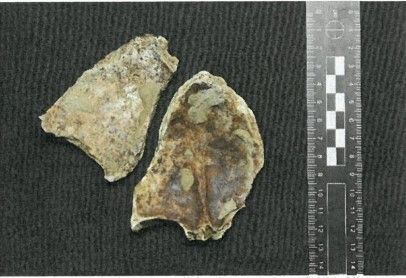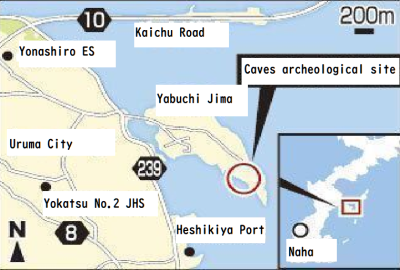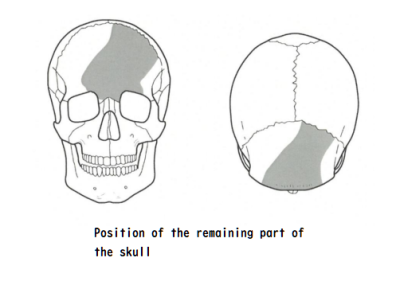9,000-10,000-year-old bone fragments discovered in Okinawa thought to be missing link between Paleolithic and Kaizuka-era humans

The skull fragments discovered in the Yabuchi Caves in Uruma
November 8, 2021 Ryukyu Shimpo
The Uruma Board of Education (BoE) announced November 8 that human remains dating back as far as 9,000-10,000 years was discovered at the Yabuchi Caves archeological site in Uruma. The remains appear to be skull fragments, are would be the oldest human remains of the Kaizuka people ever discovered. This is the first human remains discovered dating to the period between the Paleolithic era 14,000 years ago and the Kaizuka era 7,000 years ago. The discovery is thought to be a valuable “missing link” between the two.
In the Okinawan archipelago, the time period after the Paleolithic up until around the 11th-century B.C.E. known as the Jomon era in mainland Japan is called the “Kaizuka era.” In Okinawa, the Minatogawa people from around 22,000 years ago represent the oldest Paleolithic human remains ever found in Japan. However, before now the oldest remains from the Kaizuka era were around 7,000 years old, discovered in the Ufudobaru ruins Nago.
 The Uruma BoE conducted an archeological survey at the Yabuchi Caves from 2014-2016. In 2016, 9,000-year-old pottery fragments
The Uruma BoE conducted an archeological survey at the Yabuchi Caves from 2014-2016. In 2016, 9,000-year-old pottery fragments
were discovered, the oldest ever found in Okinawa. These human remains were also excavated during this dig, and w
ere confirmed to be from the Kaizuka era based on the geological stratum and morphological features of the bone fragments.
The two skull fragments were excavated from around 60-70 cm below the surface, with both fragments being around 10 cm in size. One of the bones is from the frontal bone of the skull, located between the eyebrows, and the gentle arch leads researchers to hypothesize that it belongs to a female. Additionally, there is a coronal suture, tissue that connects the frontal and parietal bones, present, suggesting that the age of the person was in their prime adult years, older than a teenager but under 40. Comparing it to other Kaizuka-era remains, it also appears to have the characteristic rectangular eye socket.
Since the bone fragments are in good condition, the city has indicated that it may be possible to uncover additional human remains from the surrounding area. They will also continue to study any possible connections between Paleolithic and Kaizuka peoples.
 The remains, as well as some of the earthenware uncovered in the Yabuchi Caves, will be on display at the Amawari History and Culture Museum in Katsuren, Uruma from November 9-21 and December 14-January 30. From November 23-December 5 they will be exhibited at the Okinawa Prefectural Museum.
The remains, as well as some of the earthenware uncovered in the Yabuchi Caves, will be on display at the Amawari History and Culture Museum in Katsuren, Uruma from November 9-21 and December 14-January 30. From November 23-December 5 they will be exhibited at the Okinawa Prefectural Museum.
(English translation by T&CT and Sam Grieb)
Previous Article:“I can’t pay rent” coronavirus-related loss of income leads to surge in financial hardship consultations in Naha during 2020
Next Article:Kin Town Council requests investigation and countermeasures pertaining to PFAS in tap water
[Similar Articles]
- 24000 year-old human remains discovered at Shiraho Saonetabaru Cave Ruins in Ishigaki City
- Shiraho Saonetabaru Cave Ruins confirmed as first graveyard during Old Stone Age in the country
- Japan’s oldest shell tools found in Sakitari Cave in Okinawa
- Okinawa is the “treasure trove” for discovering prehistoric human remains
- Human bones dating back 9,000 years found at Sakitari Cave
 Webcam(Kokusai Street)
Webcam(Kokusai Street)


